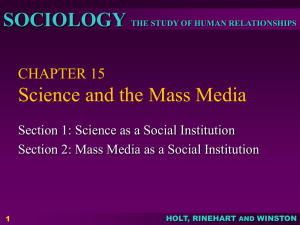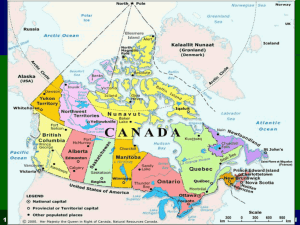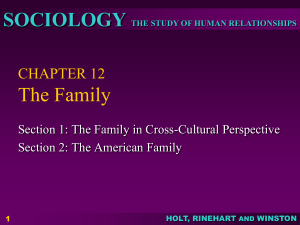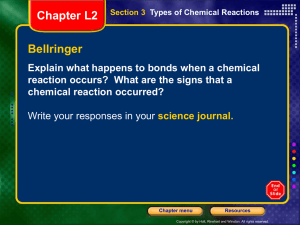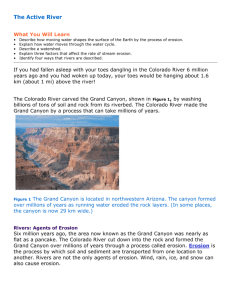drainage atmosphere
advertisement
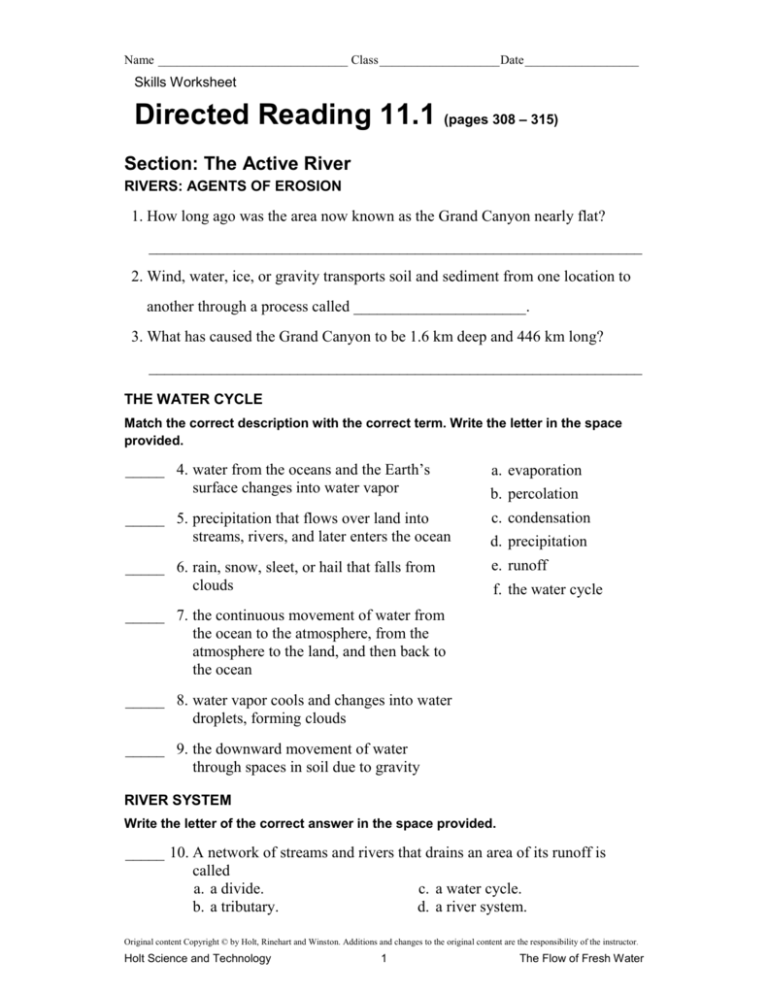
Name ______________________________ Class ___________________ Date __________________ Skills Worksheet Directed Reading 11.1 (pages 308 – 315) Section: The Active River RIVERS: AGENTS OF EROSION 1. How long ago was the area now known as the Grand Canyon nearly flat? _______________________________________________________________ 2. Wind, water, ice, or gravity transports soil and sediment from one location to another through a process called ______________________. 3. What has caused the Grand Canyon to be 1.6 km deep and 446 km long? _______________________________________________________________ THE WATER CYCLE Match the correct description with the correct term. Write the letter in the space provided. _____ 4. water from the oceans and the Earth’s surface changes into water vapor _____ 5. precipitation that flows over land into streams, rivers, and later enters the ocean _____ 6. rain, snow, sleet, or hail that falls from clouds a. evaporation b. percolation c. condensation d. precipitation e. runoff f. the water cycle _____ 7. the continuous movement of water from the ocean to the atmosphere, from the atmosphere to the land, and then back to the ocean _____ 8. water vapor cools and changes into water droplets, forming clouds _____ 9. the downward movement of water through spaces in soil due to gravity RIVER SYSTEM Write the letter of the correct answer in the space provided. _____ 10. A network of streams and rivers that drains an area of its runoff is called a. a divide. c. a water cycle. b. a tributary. d. a river system. Original content Copyright © by Holt, Rinehart and Winston. Additions and changes to the original content are the responsibility of the instructor. Holt Science and Technology 1 The Flow of Fresh Water Name ______________________________ Class ___________________ Date __________________ Directed Reading A continued 11. A stream that flows into a lake or larger stream is a______________________. 12. The area of land that is drained by a water system is called a ______________________, or drainage basin. 13. What watershed covers more than one-third of the United States? ______________________ 14. The boundary between drainage areas that have streams that flow in opposite directions is a ______________________. STREAM EROSION 15. A path that a stream follows is a(n) ______________________. 16. When streams become longer and wider, they are called ______________________. Match the correct definition with the correct term. Write the letter in the space provided. _____ 17. the materials carried by a stream _____ 18. the measure of the change in elevation over a certain distance a. discharge b. load c. gradient _____ 19. the amount of water a stream or river carries in a given amount of time 20. What effect does the gradient of a stream have on the amount of energy it has for eroding soil and rock? _______________________________________________________________ _______________________________________________________________ _______________________________________________________________ 21. When a stream’s discharge increases, what happens to its erosive energy? _______________________________________________________________ _______________________________________________________________ Original content Copyright © by Holt, Rinehart and Winston. Additions and changes to the original content are the responsibility of the instructor. Holt Science and Technology 2 The Flow of Fresh Water Name ______________________________ Class ___________________ Date __________________ Directed Reading A continued 22. What effect does the speed a stream flows have on the size of the particles it is able to carry? _______________________________________________________________ _______________________________________________________________ 23. What effect does the size of the particles that make up a stream’s load have on its erosive energy? _______________________________________________________________ _______________________________________________________________ 24. What is the difference between a bed load and a dissolved load? _______________________________________________________________ _______________________________________________________________ 25. What is a suspended load? _______________________________________________________________ _______________________________________________________________ THE STAGES OF A RIVER Write the letter of the correct answer in the space provided. _____ 26. In the early 1900s, William Morris Davis developed a model for a. measuring the gradients of rivers. b. the folly of youth. c. the wisdom of old age. d. the stages of river development. _____ 27. What do the terms used in Davis’s model describe? a. the rate of river erosion c. a river’s general features b. the gradient of a river d. a river’s actual age _____ 28. A quickly flowing river with a narrow channel that tumbles over many rocks and has few tributaries is a. a youthful river. c. an old river. b. a mature river. d. a rejuvenated river. _____ 29. A river that has a wide channel and few falls and rapids and is fed by many tributaries is a. a youthful river. c. an old river. b. a mature river. d. a rejuvenated river. Original content Copyright © by Holt, Rinehart and Winston. Additions and changes to the original content are the responsibility of the instructor. Holt Science and Technology 3 The Flow of Fresh Water Name ______________________________ Class ___________________ Date __________________ Directed Reading A continued _____ 30. Why does a mature river have more discharge than a youthful river? a. because a mature river is longer b. because a mature river is shorter c. because of its poor drainage d. because of its good drainage _____ 31. A river with a low gradient, a wide, flat floodplain, and many bends is called a. a youthful river. c. an old river. b. a mature river. d. a rejuvenated river. _____ 32. A river that is found where the land is raised by tectonic activity is a. a youthful river. c. and old river. b. a mature river. d. a rejuvenated river. _____ 33. The step like formations that often form on both sides of a stream valley as a result of rejuvenation are called a. meanders. c. stages. b. terraces. d. youths. 34. What is the difference between a youthful river and a mature river? _______________________________________________________________ _______________________________________________________________ _______________________________________________________________ _______________________________________________________________ 35. What is the result of an old river not having much erosive energy? _______________________________________________________________ _______________________________________________________________ 36. How does tectonic activity help make a rejuvenated river? _______________________________________________________________ _______________________________________________________________ _______________________________________________________________ _______________________________________________________________ _______________________________________________________________ Original content Copyright © by Holt, Rinehart and Winston. Additions and changes to the original content are the responsibility of the instructor. Holt Science and Technology 4 The Flow of Fresh Water


